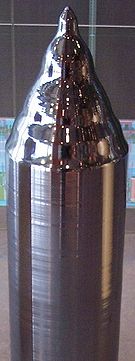- Monocrystalline silicon
-
Monocrystalline silicon or single-crystal Si, or mono-Si is the base material of the electronic industry. It consists of silicon in which the crystal lattice of the entire solid is continuous, unbroken (with no grain boundaries) to its edges. It can be prepared intrinsic, i.e. made of exceedingly pure silicon alone, or doped, containing very small quantities of other elements added to change in a controlled manner its semiconducting properties. Most silicon monocrystals are grown by the Czochralski process, in the shape of cylinders up to 2 m long and 30 cm in diameter (figure on the left), which, cut in thin slices, give the wafers onto which the microcircuits will be fabricated.
Single-crystal silicon is perhaps the most important technological material of the last decades (the "silicon era"),[1] because its availability at an affordable cost has been essential for the development of the electronic devices on which the present day electronic and informatic revolution is based.
 VLSI devices (Intel) fabricated on a single-crystal silicon wafer)
VLSI devices (Intel) fabricated on a single-crystal silicon wafer)
Monocrystalline is opposed to amorphous silicon, in which the atomic order is limited to short range order only. In between the two extremes there is polycrystalline silicon, which is made up of small crystals, known as crystallites.
Contents
Mono-Si in electronics
The monocrystalline form is used in the semiconductor device fabrication since grain boundaries would bring discontinuities and favor imperfections in the microstructure of silicon, such as impurities and crystallographic defects, which can have significant effects on the local electronic properties of the material. On the scale that devices operate on, these imperfections would have a significant impact on the functionality and reliability of the devices. Without the crystalline perfection, it would be virtually impossible to build Very Large-Scale Integration (VLSI) devices (figure at right), in which millions (up to billions, circa 2005[2]) of transistor-based circuits, all of which must reliably be working, are combined into a single chip to get e.g. a microprocessor. Therefore, electronic industry has invested heavily in facilities to produce large single crystals of silicon.
Mono-Si in solar cells
 A solar cell made from a mono-silicon wafer
A solar cell made from a mono-silicon wafer
Monocrystalline silicon is also used in the manufacturing of high performance solar cells. Since, however, solar cells are less demanding than microelectronics for as concerns structural imperfections, monocrystaline solar grade (Sog-Si) is often used, single crystal is also often replaced by the cheaper polycrystalline or multicrystalline silicon.[3] Monocrystalline solar cells can achieve 17% efficiency[4] whereas other types of less expensive cells including thin film and polycrystalline are only capable of achieving around 10% efficiency.[5]
Few solar charger companies use monocrystalline solar panels because of the higher cost to produce the solar cells, although these higher efficiency products are starting to pop up as consumers demand more efficient products. The 2010 Consumer Electronics Show showcased one of these high-efficiency monocrystalline chargers known as the JOOS Orange and awarded it the 2010 Best of Innovations Award.[6] The charger is manufactured by SolarJOOS, a Silicon Valley based solar company.
References
- ^ W.Heywang, K.H.Zaininger, Silicon: the semiconductor material, in Silicon: evolution and future of a technology, P.Siffert, E.F.Krimmel eds., Springer Verlag, 2004.
- ^ Peter Clarke, Intel enters billion-transistor processor era, EE Times, 14 October 2005
- ^ S.R.Wenham, M.A.Green, M.E.Watt., R.Corkish, Applied Photovoltaics, Earthscan, 2007, Chapt. 2
- ^ Georgia Tech, SmartTech Search
- ^ The Institute of Energy Conversion, University of Delaware, Thin Film Solar Cell Status
- ^ 2011 Best of Innovations Award Winners 4 January 2011, Consumer Electronics Association
External links
Categories:- Semiconductor materials
- Crystals
- Silicon solar cells
Wikimedia Foundation. 2010.


